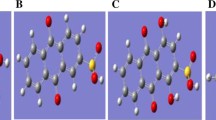Summary
The random-phase approximation is applied to analyse the circular dichroism of the lowest electronic transitions of this molecule. The RPA equations are reduced to effective eigenvalue equations and the effective Hamiltonians analysed in Tamm-Dancoff (TD) and correlation interactions. It is shown that correlation provides important contributions and is essential to predict the correct sign of the lowest electronic transitions.
Riassunto
L'approssimazione delle fasi casuali è applicata all'analisi del dicroismo circolare delle transizioni elettroniche a più bassa energia di questa molecola. Le equazioni RPA sono ridotte a equazioni agli autovalori relative ad un'hamiltoniana efficace che viene successivamente analizzata in contributi del tipo di Tamm-Dancoff e di correlazione. Si mostra che la correlazione fornisce importanti contributi ed è essenziale per prevedere il corretto segno delle transizioni elettroniche a più bassa energia.
Резюме
Приближение случайных фаз применяется для анализа кругового дихроизма в случае низших электронных переходов для этой молекулы. Уравнения приближения случайных фаз сводятся к уравнениям для эффективных собственных значений. Эффективные гамильтонианы анализируются в рамках приближения Тамма-Данкова и корреляционных взаимодействий. Показывается, что указанная корреляция обеспечивает важные вклады и, по существу, предсказывает правильный знак низших электронных переходов.
Similar content being viewed by others
References
D. J. Rowe:Rev. Mod. Phys.,40, 153 (1968).
T. I. Shibuya, J. Rose andV. McKoy:J. Chem. Phys.,58, 500 (1973).
T. I. Shibuya andV. McKoy:J. Chem. Phys.,53, 3308 (1970).
T. D. Bouman andAa. E. Hansen:J. Chem. Phys.,66, 3460 (1977).
T. D. Bouman andAa. E. Hansen:Chem. Phys. Lett.,53, 160 (1978).
T. D. Bouman, B. Voigt andAa. E. Hansen:J. Am. Chem. Soc.,101, 550 (1979).
T. D. Bouman andAa. E. Hansen:Mol. Phys.,37, 1713 (1979).
S. Cadiali, G. Gottarelli, B. Samorì andP. Palmieri:J. Chem. Soc. Perkin Trans. 2 (in press).
G. L. Bendazzoli, G. Gottarelli andP. Palmieri:J. Am. Chem. Soc.,96, 11 (1974).
G. L. Bendazzoli, G. Gottarelli, P. Palmieri, B. Samorì andA. F. Drake:Chem. Phys. Lett.,45, 318 (1977).
S. P. McGlynn, T. Azumi andM. Kinoshita: inMolecular Spectroscopy of the Triplet State (Englewood Cliffs, N. J., 1969), p. 162.
W. J. Hehre, R. F. Stewart andJ. A. Pople:J. Chem. Phys.,51, 2657 (1969).
The rotational strengths of tables I and II have been computed with the dipole velocity representation of the electric-dipole operator.
For leading references seeT. D. Bouman andD. A. Lightner:J. Am. Chem. Soc.,98, 3145 (1976).
P. O. Löwdin: inPerturbation Theory and Its Applications to Quantum Mechanics, edited byC. H. Wilcox (New York, N. Y., 1966).
Author information
Authors and Affiliations
Additional information
Переведено редакцией.
Rights and permissions
About this article
Cite this article
Bendazzoli, G.L., Palmieri, P., Evangelisti, S. et al. The optical activity of tetrahydroquinoline in the random-phase approximation. The importance of the correlation energy contributions to the optical activity. Nuov Cim B 60, 106–112 (1980). https://doi.org/10.1007/BF02723072
Received:
Published:
Issue Date:
DOI: https://doi.org/10.1007/BF02723072




